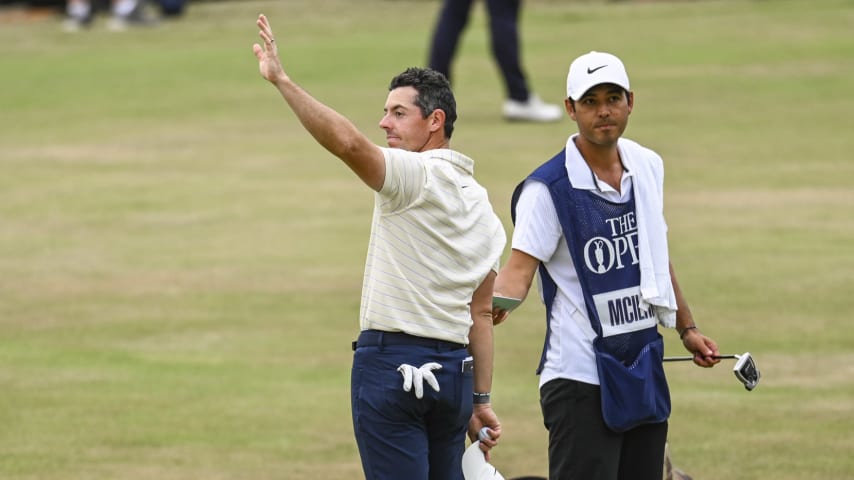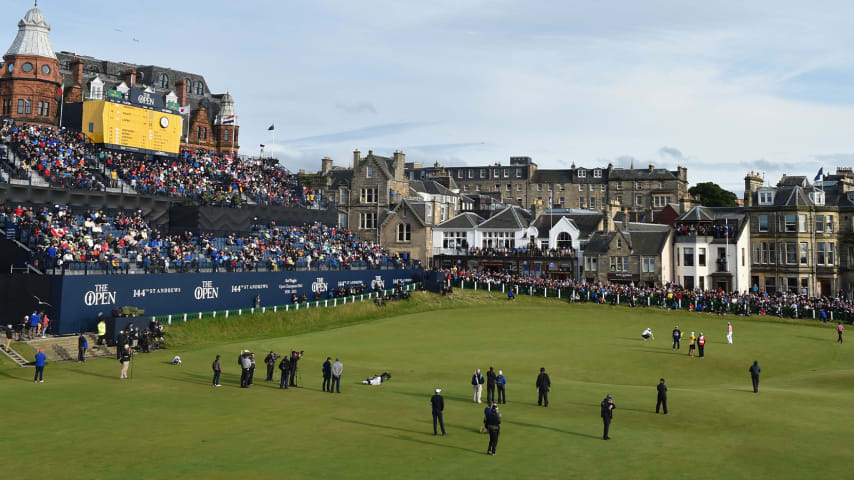Five Things to Know before The Open’s first round
7 Min Read

Written by Sean Martin
ST. ANDREWS, Scotland – This week, the game’s oldest major celebrates a milestone in golf’s most historic setting. After a one-year delay, The Open has returned to St. Andrews, where players follow the footsteps of the greats across the Swilcan Bridge and into “a city given over, soul and body, to a tyrannizing game.” This is the 150th Open and the 30th played on the Old Course at St. Andrews. Tiger Woods, already a winner of two Opens at St. Andrews, has had this date circled on his calendar throughout his comeback. Collin Morikawa is trying to successfully defend the title he won in his Open debut and Scottie Scheffler, Justin Thomas and Matt Fitzpatrick are all trying to win a second major this year.
“There is nothing like it anywhere else, visually or architecturally,” Jack Nicklaus said about the Old Course. That’s what awaits the field come Thursday. To prepare you for the start of The 150th Open, here’s Five Things to Know about this year’s tournament.
1. MOMENTOUS OCCASION
Even for players focused on winning a major championship this week, the history of St. Andrews cannot be missed.
Players aim at ancient buildings and church steeples as they head toward the Old, Grey Town on the inward nine. The game’s greats have been crossing the Swilcan Bridge since the first Open was played here in 1873. The 18th green, which sits in the shadow of the R&A clubhouse, is across the street from the shop where Old Tom Morris made balls and clubs in the 19th century. Visitors to St. Andrews can still visit the graves of Old Tom and his son, who each won The Open four times, as well as the oldest university in Scotland and the ruins of the town’s cathedral, which was completed in the 14th century.
“It is history every time we get a chance to play here,” said Woods, who won here in 2000 and 2005 by a combined 13 shots. Woods still has a photo hanging in his office of him on the Swilcan Bridge during his Open debut in 1995. He watched Arnold Palmer play his final Open that year, and a decade later could hear the roars as Nicklaus concluded his career at the Old Course.
“It’s the most historic (Open) we've ever had,” Woods said about this year’s edition. Will Zalatoris said “the excitement level is off the charts.”
And Jon Rahm added, “I don't think it gets any better than winning at St. Andrews. No offense to any other tournament in the world. It's the oldest championship on the oldest course and where it all started.”
Woods and Nicklaus each won here twice, and the list of winners at St. Andrews also includes legends like Bobby Jones, Sam Snead, Peter Thomson, Bobby Locke, Seve Ballesteros and Nick Faldo.
2. FIRM AND FAST
The course conditions should only add to the intrigue this week. The Old Course is playing firm and fast, requiring players to be even more precise in their quest to avoid all 112 bunkers on the property. Rory McIlroy called it a “game of chess” because it will keep players from bashing drivers with impunity in an attempt to bludgeon the course into submission. Players will have to plot their way around, play the angles and use the Old Course’s slopes and swales to get close to the hole.
“You’re going to maybe see guys laying back a little bit, … giving yourself full shots into some of these greens, playing the angle a little bit more,” said McIlroy. “It’s definitely a lot more of a strategic golf course when it plays like this.”
While concerns about players overpowering the Old Course are ever-present, players can’t use brute strength when the course is playing this way. Getting too close to the green can leave an awkward approach shot that doesn’t have enough spin. Mishits will only be exacerbated as balls roll away from the target and unexpected bounces can cause balls to go in the rough or bunkers.
“You’re going to get some good bounces and probably some bad ones,” said Morikawa.
Added Thomas, “It’s going to be a lot more difficult to keep the ball in the fairway, which will make it more difficult to control it into the greens and get the ball closer to the hole.”
3. FORE-CAST
Weather at The Open is always a factor. The only predictable thing is the forecast will be unpredictable.
Wild weather had a huge impact in the last two Opens at St. Andrews, with high winds leading to a Monday finish seven years ago.
No such chaos is currently on the cards for the iconic links. The latest forecast calls for moderate wins for the start of competition and plenty of dry weather is expected.
On the eve of the 150th Open experts predict Thursday’s opening round will bring, “a dry and bright start,” much to the delight of the hundreds of thousands of fans expected to attend this week.
If a perceived advantage exists it might be with the early/late wave as the opening round might get stronger winds in the evening. Temperatures will be in the mid-60s for the first two days and the wind isn’t expected to exceed 20 mph. The weekend should be even warmer, with Sunday expecting a high of 75 degrees, and wind once again should top out at about 20 mph.
4. TEE TIMES
Scotland’s Paul Lawrie, winner of the 1999 Open Championship, will lead things off Thursday at 6:35 a.m. local time (that’s 1:35 a.m. on the East Coast of the U.S. and 10:35 p.m. Wednesday in California). Thursday’s final group will tee off nearly 10 hours later.
There are plenty of star-studded groups in between.
Woods is playing with U.S. Open winner Matt Fitzpatrick of England and Max Homa, a two-time winner this season who is fulfilling a childhood dream by playing with Woods for the first time. The trio starts the opening round at 2:59p.m. local time.
The defending champion, Collin Morikawa, and the hottest player in the game, Xander Schauffele, are playing with four-time major winner Rory McIlroy, at 9:58 a.m. Thursday. They’re followed by PGA Championship winner Justin Thomas, who’s playing with former Open champion Shane Lowry and three-time TOUR winner Viktor Hovland. The 10:20 a.m. tee time features Will Zalatoris, runner-up in the last two majors, with Hideki Matusyama and Tony Finau.
FedExCup leader and world No. 1 Scottie Scheffler tees off at 1:26p.m. with Genesis Invitational champion Joaquin Niemann and England’s Tyrrell Hatton, while Jon Rahm is joined by Jordan Spieth and Harold Varner III at 3:10p.m. in the group behind Woods. FedExCup champ Patrick Cantlay is playing with Sam Burns, who’s No. 2 in this year’s standings thanks to three wins, and Mito Pereira. They will tee off at 3:21 p.m.
5. ROAD HOLE
A return to St. Andrews means the return of the Road Hole, one of the hardest in the world. Whenever the Old Course hosts The Open, its 17th hole ranks as the hardest on the entire TOUR. Players generally average more than 4.6 strokes on it. The 495-yard hole has several distinct features, including the shed that impedes players’ view of the fairway, the deep bunker that guards the green and the road behind the putting surface that gives the hole its name and that players must play from if they go long. It’s one of the most unique holes in the world, one that even Justin Thomas had trouble describing. Words can’t do it justice.
“Trying to explain that hole and that tee shot to my fiancée was a little bit difficult,” Thomas said. “So I had to take her out there myself. I'm like, no, you hit it over the hotel. It's like, OK, but not really. I'm like, Oh, no, really.”
Rahm called it a “proper championship hole.” Bailing out to the left to avoid the out-of-bounds only leaves players with a poor angle to the green and staring directly at the Road Hole bunker, where players like Tommy Nakajima and David Duval have seen their Open hopes dashed.
“If you hit it into that left rough, it sort of takes all your options away,” said McIlroy. “You've just got to hit it to the front right and then try to make your two-putts from there. The tee shoot is key.”
It was Ben Crenshaw who said, “The reason the Road Hole is the greatest par-4 in the world is because it's a par-5.”





